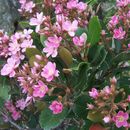en
names in breadcrumbs


Rhaphiolepis indica, the Indian hawthorn, India hawthorn or Hong Kong hawthorn is an evergreen shrub in the family Rosaceae.
They are shrubs or small trees, which rarely reach a size of 4 m in height. The branches are purple brown when young, greyish brown when old, cylindrical, initially brown tomentose, glabrous in old age. Petiole 0.5–1.8 cm or almost absent, slightly brown or tomentose, subglabrous; stipules deciduous, lanceolate, little brown tomentose, acuminate apex; ovate blade blade, oblong, rarely obovate, oblong-lanceolate, narrowly elliptical or elliptical-lanceolate, (2–) 4–8 × 1.5–4 cm, coriaceous, abaxially prominent veins, abaxially visible reticular veins and visible or non-adaxially, back pale, glabrous or scarcely tomentose, shiny adaxially, glabrous, the apex obtuse, acute acuminate.
The inflorescences in panicles or terminal of clusters, with many or few flowers; pedicels and peduncles rusty-tomentose; bracts and deciduous bracteoles. Flowers 1–1.5 cm in diameter. The petals white or pink, obovate or lanceolate, 5–7 × 4–5 mm, pubescent basal, obtuse apex. Stamens 15, as long or shorter than the petals.[1]
It is found on slopes, roadsides, bushes on the sides of streams; at an altitude of 700–1600 meters above sea level in an areas such as, southern China, Japan, Laos, Cambodia, Thailand and Vietnam.[2]
It is grown for its decorative pink or white flowers, and is popular in bonsai culture. The fruit is edible when cooked, and can be used to make jam.
Indian hawthorn is a mainstay horticultural specimen in southern United States. It is often found in commercial as well as in private landscapes. Often it is trimmed into small compact hedges or balls for foundation plants. It has been successfully pruned into a standard form as well as small dwarf-like trees up to 15 feet in height. It is apt to develop leaf spot.
The plant is also known as "teechigi" and its pulp is known as "sharinbai" (しゃりんばい / テーチ木 / テカチ木) in Japan and a dark brown dye is made by boiling its dried bark or root and using iron or lime water as a mordant. This plant has been used in Japan for over 400 years in a technique for making pongo silk fabrics. In the Kainan islands in China it is used to make shima-tsumugi textiles and some fishing nets.[3] Additionally, the plant is used in a Japanese mud dyeing technique known as dorozome from the Amami Islands. In dorozome, branches are chopped into small chips and simmered in large cauldrons for two days. The pulp is then filtered out and yarn is steeped in the golden-orange extract. The more the yarn is dipped and dried, the darker and richer the color is.[4]
![]() Media related to Rhaphiolepis indica at Wikimedia Commons
Media related to Rhaphiolepis indica at Wikimedia Commons
Rhaphiolepis indica, the Indian hawthorn, India hawthorn or Hong Kong hawthorn is an evergreen shrub in the family Rosaceae.
Rhaphiolepis indica, es un arbusto perteneciente a la familia Rosaceae. Es originaria del sur de China.
Son arbustos, árboles pequeños, que rara vez alcanza un tamaño de 4 m de altura. Las ramas son de color marrón púrpura cuando son jóvenes, marrón grisáceo cuando es viejo, cilíndricos, inicialmente marrón tomentoso, glabras en la vejez. Pecíolo 0.5-1.8 cm o casi ausentes, ligeramente marrón o tomentosos, subglabra; estípulas caducas, lanceoladas, de color marrón poco tomentoso, ápice acuminado; ovadas hoja de cuchilla, oblongas, rara vez obovadas, oblongo-lanceoladas, estrechamente elípticas o elíptico-lanceoladas, (2 -) 4-8 × 1.5-4 cm, coriáceas, venas prominentes abaxialmente, venas reticulares visibles abaxialmente y visible o no adaxialmente, envés pálido, glabro o escasamente tomentoso, brillante adaxialmente, glabra, el ápice obtuso, agudo acuminado. Las inflorescencias en panículas o terminal de racimos, con muchas o pocas flores; pedicelos y pedúnculos oxidado tomentoso; brácteas y bracteolas caducas. Flores 1-1.3 (-1.5) cm de diámetro. Los pétalos de color blanco o rosado, obovadas o lanceoladas, 5-7 × 4-5 mm, pubescentes basales, ápice obtuso. Estambres 15, tan largo o más corto que los pétalos. Pomo negro violáceo, globoso, 5-8 mm de diámetro, glabro. Fl. abril, fr. julio-agosto.[1]
Se encuentra en las pendientes, bordes de caminos, matorrales a los lados de corrientes; a una altitud de 700 - 1600 metros en Anhui, Fujian, Cantón, Guangxi, Guizhou, Hainan, Hunan, Jiangxi, Taiwán, Yunnan, Zhejiang en China y en Camboya, Japón, Laos, Tailandia y Vietnam.
El fruto es comestible cuando se cocina, y se puede utilizar para hacer mermelada.
Especie ornamental, produce unas bellas flores rosas y es muy popular en la cultura del bonsái.
Se usa de apoyo principal hortícola en el sur de Estados Unidos. Se encuentra a menudo en los paisajes privados. A menudo se corta en pequeños setos compactos.
Rhaphiolepis indica fue descrita por (L.) Lindl. ex Ker Gawl. y publicado en Botanical Register; consisting of coloured . . . 6:pl. 468. 1820.[2]
Rhaphiolepis indica, es un arbusto perteneciente a la familia Rosaceae. Es originaria del sur de China.
Đào bánh xe[1] (danh pháp khoa học: Rhaphiolepis indica) là loài thực vật có hoa trong họ Hoa hồng. Loài này được (L.) Lindl. ex Ker miêu tả khoa học đầu tiên năm 1820.[2]
Đào bánh xe (danh pháp khoa học: Rhaphiolepis indica) là loài thực vật có hoa trong họ Hoa hồng. Loài này được (L.) Lindl. ex Ker miêu tả khoa học đầu tiên năm 1820.
石斑木(学名:Rhaphiolepis indica),又名田代氏石斑木、假厚皮香木、台灣白杏花木、白杏花木、印度石斑木、刻脈石斑木、春花木、春花、雷公樹木、尖梅花,为蔷薇科石斑木属下的一个种。